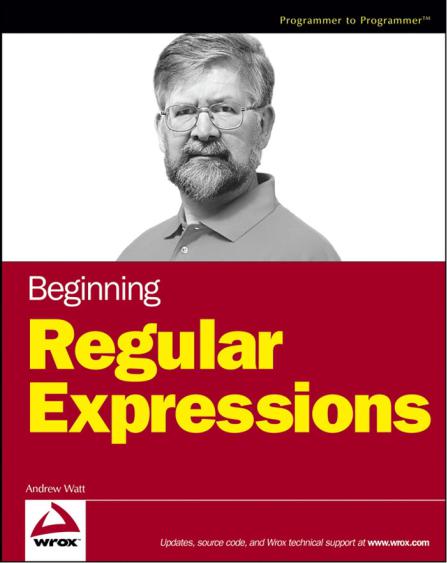
- •Introduction
- •Who This Book Is For
- •What This Book Covers
- •How This Book Is Structured
- •What You Need to Use This Book
- •Conventions
- •Source Code
- •Errata
- •p2p.wrox.com
- •What Are Regular Expressions?
- •What Can Regular Expressions Be Used For?
- •Finding Doubled Words
- •Checking Input from Web Forms
- •Changing Date Formats
- •Finding Incorrect Case
- •Adding Links to URLs
- •Regular Expressions You Already Use
- •Search and Replace in Word Processors
- •Directory Listings
- •Online Searching
- •Why Regular Expressions Seem Intimidating
- •Compact, Cryptic Syntax
- •Whitespace Can Significantly Alter the Meaning
- •No Standards Body
- •Differences between Implementations
- •Characters Change Meaning in Different Contexts
- •Regular Expressions Can Be Case Sensitive
- •Case-Sensitive and Case-Insensitive Matching
- •Case and Metacharacters
- •Continual Evolution in Techniques Supported
- •Multiple Solutions for a Single Problem
- •What You Want to Do with a Regular Expression
- •Replacing Text in Quantity
- •Regular Expression Tools
- •findstr
- •Microsoft Word
- •StarOffice Writer/OpenOffice.org Writer
- •Komodo Rx Package
- •PowerGrep
- •Microsoft Excel
- •JavaScript and JScript
- •VBScript
- •Visual Basic.NET
- •Java
- •Perl
- •MySQL
- •SQL Server 2000
- •W3C XML Schema
- •An Analytical Approach to Using Regular Expressions
- •Express and Document What You Want to Do in English
- •Consider the Regular Expression Options Available
- •Consider Sensitivity and Specificity
- •Create Appropriate Regular Expressions
- •Document All but Simple Regular Expressions
- •Document What You Expect the Regular Expression to Do
- •Document What You Want to Match
- •Test the Results of a Regular Expression
- •Matching Single Characters
- •Matching Sequences of Characters That Each Occur Once
- •Introducing Metacharacters
- •Matching Sequences of Different Characters
- •Matching Optional Characters
- •Matching Multiple Optional Characters
- •Other Cardinality Operators
- •The * Quantifier
- •The + Quantifier
- •The Curly-Brace Syntax
- •The {n} Syntax
- •The {n,m} Syntax
- •Exercises
- •Regular Expression Metacharacters
- •Thinking about Characters and Positions
- •The Period (.) Metacharacter
- •Matching Variably Structured Part Numbers
- •Matching a Literal Period
- •The \w Metacharacter
- •The \W Metacharacter
- •Digits and Nondigits
- •The \d Metacharacter
- •Canadian Postal Code Example
- •The \D Metacharacter
- •Alternatives to \d and \D
- •The \s Metacharacter
- •Handling Optional Whitespace
- •The \S Metacharacter
- •The \t Metacharacter
- •The \n Metacharacter
- •Escaped Characters
- •Finding the Backslash
- •Modifiers
- •Global Search
- •Case-Insensitive Search
- •Exercises
- •Introduction to Character Classes
- •Choice between Two Characters
- •Using Quantifiers with Character Classes
- •Using the \b Metacharacter in Character Classes
- •Selecting Literal Square Brackets
- •Using Ranges in Character Classes
- •Alphabetic Ranges
- •Use [A-z] With Care
- •Digit Ranges in Character Classes
- •Hexadecimal Numbers
- •IP Addresses
- •Reverse Ranges in Character Classes
- •A Potential Range Trap
- •Finding HTML Heading Elements
- •Metacharacter Meaning within Character Classes
- •The ^ metacharacter
- •How to Use the - Metacharacter
- •Negated Character Classes
- •Combining Positive and Negative Character Classes
- •POSIX Character Classes
- •The [:alnum:] Character Class
- •Exercises
- •String, Line, and Word Boundaries
- •The ^ Metacharacter
- •The ^ Metacharacter and Multiline Mode
- •The $ Metacharacter
- •The $ Metacharacter in Multiline Mode
- •Using the ^ and $ Metacharacters Together
- •Matching Blank Lines
- •Working with Dollar Amounts
- •Revisiting the IP Address Example
- •What Is a Word?
- •Identifying Word Boundaries
- •The \< Syntax
- •The \>Syntax
- •The \b Syntax
- •The \B Metacharacter
- •Less-Common Word-Boundary Metacharacters
- •Exercises
- •Grouping Using Parentheses
- •Parentheses and Quantifiers
- •Matching Literal Parentheses
- •U.S. Telephone Number Example
- •Alternation
- •Choosing among Multiple Options
- •Unexpected Alternation Behavior
- •Capturing Parentheses
- •Numbering of Captured Groups
- •Numbering When Using Nested Parentheses
- •Named Groups
- •Non-Capturing Parentheses
- •Back References
- •Exercises
- •Why You Need Lookahead and Lookbehind
- •The (? metacharacters
- •Lookahead
- •Positive Lookahead
- •Negative Lookahead
- •Positive Lookahead Examples
- •Positive Lookahead in the Same Document
- •Inserting an Apostrophe
- •Lookbehind
- •Positive Lookbehind
- •Negative Lookbehind
- •How to Match Positions
- •Adding Commas to Large Numbers
- •Exercises
- •What Are Sensitivity and Specificity?
- •Extreme Sensitivity, Awful Specificity
- •Email Addresses Example
- •Replacing Hyphens Example
- •The Sensitivity/Specificity Trade-Off
- •Sensitivity, Specificity, and Positional Characters
- •Sensitivity, Specificity, and Modes
- •Sensitivity, Specificity, and Lookahead and Lookbehind
- •How Much Should the Regular Expressions Do?
- •Abbreviations
- •Characters from Other Languages
- •Names
- •Sensitivity and How to Achieve It
- •Specificity and How to Maximize It
- •Exercises
- •Documenting Regular Expressions
- •Document the Problem Definition
- •Add Comments to Your Code
- •Making Use of Extended Mode
- •Know Your Data
- •Abbreviations
- •Proper Names
- •Incorrect Spelling
- •Creating Test Cases
- •Debugging Regular Expressions
- •Treacherous Whitespace
- •Backslashes Causing Problems
- •Considering Other Causes
- •The User Interface
- •Metacharacters Available
- •Quantifiers
- •The @ Quantifier
- •The {n,m} Syntax
- •Modes
- •Character Classes
- •Back References
- •Lookahead and Lookbehind
- •Lazy Matching versus Greedy Matching
- •Examples
- •Character Class Examples, Including Ranges
- •Whole Word Searches
- •Search-and-Replace Examples
- •Changing Name Structure Using Back References
- •Manipulating Dates
- •The Star Training Company Example
- •Regular Expressions in Visual Basic for Applications
- •Exercises
- •The User Interface
- •Metacharacters Available
- •Quantifiers
- •Modes
- •Character Classes
- •Alternation
- •Back References
- •Lookahead and Lookbehind
- •Search Example
- •Search-and-Replace Example
- •Online Chats
- •POSIX Character Classes
- •Matching Numeric Digits
- •Exercises
- •Introducing findstr
- •Finding Literal Text
- •Quantifiers
- •Character Classes
- •Command-Line Switch Examples
- •The /v Switch
- •The /a Switch
- •Single File Examples
- •Simple Character Class Example
- •Find Protocols Example
- •Multiple File Example
- •A Filelist Example
- •Exercises
- •The PowerGREP Interface
- •A Simple Find Example
- •The Replace Tab
- •The File Finder Tab
- •Syntax Coloring
- •Other Tabs
- •Numeric Digits and Alphabetic Characters
- •Quantifiers
- •Back References
- •Alternation
- •Line Position Metacharacters
- •Word-Boundary Metacharacters
- •Lookahead and Lookbehind
- •Longer Examples
- •Finding HTML Horizontal Rule Elements
- •Matching Time Example
- •Exercises
- •The Excel Find Interface
- •Escaping Wildcard Characters
- •Using Wildcards in Data Forms
- •Using Wildcards in Filters
- •Exercises
- •Using LIKE with Regular Expressions
- •The % Metacharacter
- •The _ Metacharacter
- •Character Classes
- •Negated Character Classes
- •Using Full-Text Search
- •Using The CONTAINS Predicate
- •Document Filters on Image Columns
- •Exercises
- •Using the _ and % Metacharacters
- •Testing Matching of Literals: _ and % Metacharacters
- •Using Positional Metacharacters
- •Using Character Classes
- •Quantifiers
- •Social Security Number Example
- •Exercises
- •The Interface to Metacharacters in Microsoft Access
- •Creating a Hard-Wired Query
- •Creating a Parameter Query
- •Using the ? Metacharacter
- •Using the * Metacharacter
- •Using the # Metacharacter
- •Using the # Character with Date/Time Data
- •Using Character Classes in Access
- •Exercises
- •The RegExp Object
- •Attributes of the RegExp Object
- •The Other Properties of the RegExp Object
- •The test() Method of the RegExp Object
- •The exec() Method of the RegExp Object
- •The String Object
- •Metacharacters in JavaScript and JScript
- •SSN Validation Example
- •Exercises
- •The RegExp Object and How to Use It
- •Quantifiers
- •Positional Metacharacters
- •Character Classes
- •Word Boundaries
- •Lookahead
- •Grouping and Nongrouping Parentheses
- •Exercises
- •The System.Text.RegularExpressions namespace
- •A Simple Visual Basic .NET Example
- •The Classes of System.Text.RegularExpressions
- •The Regex Object
- •Using the Match Object and Matches Collection
- •Using the Match.Success Property and Match.NextMatch Method
- •The GroupCollection and Group Classes
- •The CaptureCollection and Capture Class
- •The RegexOptions Enumeration
- •Case-Insensitive Matching: The IgnoreCase Option
- •Multiline Matching: The Effect on the ^ and $ Metacharacters
- •Right to Left Matching: The RightToLeft Option
- •Lookahead and Lookbehind
- •Exercises
- •An Introductory Example
- •The Classes of System.Text.RegularExpressions
- •The Regex Class
- •The Options Property of the Regex Class
- •Regex Class Methods
- •The CompileToAssembly() Method
- •The GetGroupNames() Method
- •The GetGroupNumbers() Method
- •GroupNumberFromName() and GroupNameFromNumber() Methods
- •The IsMatch() Method
- •The Match() Method
- •The Matches() Method
- •The Replace() Method
- •The Split() Method
- •Using the Static Methods of the Regex Class
- •The IsMatch() Method as a Static
- •The Match() Method as a Static
- •The Matches() Method as a Static
- •The Replace() Method as a Static
- •The Split() Method as a Static
- •The Match and Matches Classes
- •The Match Class
- •The GroupCollection and Group Classes
- •The RegexOptions Class
- •The IgnorePatternWhitespace Option
- •Metacharacters Supported in Visual C# .NET
- •Using Named Groups
- •Using Back References
- •Exercise
- •The ereg() Set of Functions
- •The ereg() Function
- •The ereg() Function with Three Arguments
- •The eregi() Function
- •The ereg_replace() Function
- •The eregi_replace() Function
- •The split() Function
- •The spliti() Function
- •The sql_regcase() Function
- •Perl Compatible Regular Expressions
- •Pattern Delimiters in PCRE
- •Escaping Pattern Delimiters
- •Matching Modifiers in PCRE
- •Using the preg_match() Function
- •Using the preg_match_all() Function
- •Using the preg_grep() Function
- •Using the preg_quote() Function
- •Using the preg_replace() Function
- •Using the preg_replace_callback() Function
- •Using the preg_split() Function
- •Supported Metacharacters with ereg()
- •Using POSIX Character Classes with PHP
- •Supported Metacharacters with PCRE
- •Positional Metacharacters
- •Character Classes in PHP
- •Documenting PHP Regular Expressions
- •Exercises
- •W3C XML Schema Basics
- •Tools for Using W3C XML Schema
- •Comparing XML Schema and DTDs
- •How Constraints Are Expressed in W3C XML Schema
- •W3C XML Schema Datatypes
- •Derivation by Restriction
- •Unicode and W3C XML Schema
- •Unicode Overview
- •Using Unicode Character Classes
- •Matching Decimal Numbers
- •Mixing Unicode Character Classes with Other Metacharacters
- •Unicode Character Blocks
- •Using Unicode Character Blocks
- •Metacharacters Supported in W3C XML Schema
- •Positional Metacharacters
- •Matching Numeric Digits
- •Alternation
- •Using the \w and \s Metacharacters
- •Escaping Metacharacters
- •Exercises
- •Introduction to the java.util.regex Package
- •Obtaining and Installing Java
- •The Pattern Class
- •Using the matches() Method Statically
- •Two Simple Java Examples
- •The Properties (Fields) of the Pattern Class
- •The CASE_INSENSITIVE Flag
- •Using the COMMENTS Flag
- •The DOTALL Flag
- •The MULTILINE Flag
- •The UNICODE_CASE Flag
- •The UNIX_LINES Flag
- •The Methods of the Pattern Class
- •The compile() Method
- •The flags() Method
- •The matcher() Method
- •The matches() Method
- •The pattern() Method
- •The split() Method
- •The Matcher Class
- •The appendReplacement() Method
- •The appendTail() Method
- •The end() Method
- •The find() Method
- •The group() Method
- •The groupCount() Method
- •The lookingAt() Method
- •The matches() Method
- •The pattern() Method
- •The replaceAll() Method
- •The replaceFirst() Method
- •The reset() Method
- •The start() Method
- •The PatternSyntaxException Class
- •Using the \d Metacharacter
- •Character Classes
- •The POSIX Character Classes in the java.util.regex Package
- •Unicode Character Classes and Character Blocks
- •Using Escaped Characters
- •Using Methods of the String Class
- •Using the matches() Method
- •Using the replaceFirst() Method
- •Using the replaceAll() Method
- •Using the split() Method
- •Exercises
- •Obtaining and Installing Perl
- •Creating a Simple Perl Program
- •Basics of Perl Regular Expression Usage
- •Using the m// Operator
- •Using Other Regular Expression Delimiters
- •Matching Using Variable Substitution
- •Using the s/// Operator
- •Using s/// with the Global Modifier
- •Using s/// with the Default Variable
- •Using the split Operator
- •Using Quantifiers in Perl
- •Using Positional Metacharacters
- •Captured Groups in Perl
- •Using Back References in Perl
- •Using Alternation
- •Using Character Classes in Perl
- •Using Lookahead
- •Using Lookbehind
- •Escaping Metacharacters
- •A Simple Perl Regex Tester
- •Exercises
- •Index


Beginning Regular Expressions
Andrew Watt


Beginning Regular Expressions


Beginning Regular Expressions
Andrew Watt

Beginning Regular Expressions
Published by
Wiley Publishing, Inc. 10475 Crosspoint Boulevard Indianapolis, IN 46256 www.wiley.com
Copyright © 2005 by Wiley Publishing, Inc., Indianapolis, Indiana
Published simultaneously in Canada
ISBN: 0-7645-7489-2
No part of this publication may be reproduced, stored in a retrieval system or transmitted in any form or by any means, electronic, mechanical, photocopying, recording, scanning or otherwise, except as permitted under Sections 107 or 108 of the 1976 United States Copyright Act, without either the prior written permission of the Publisher, or authorization through payment of the appropriate per-copy fee to the Copyright Clearance Center, 222 Rosewood Drive, Danvers, MA 01923, (978) 750-8400, fax (978) 646-8600. Requests to the Publisher for permission should be addressed to the Legal Department, Wiley Publishing, Inc., 10475 Crosspoint Blvd., Indianapolis, IN 46256, (317) 572-3447, fax (317) 572-4355, e-mail: brandreview@wiley.com.
LIMIT OF LIABILITY/DISCLAIMER OF WARRANTY: THE PUBLISHER AND THE AUTHOR MAKE NO REPRESENTATIONS OR WARRANTIES WITH RESPECT TO THE ACCURACY OR COMPLETENESS OF THE CONTENTS OF THIS WORK AND SPECIFICALLY DISCLAIM ALL WARRANTIES, INCLUDING WITHOUT LIMITATION WARRANTIES OF FITNESS FOR A PARTICULAR PURPOSE. NO WARRANTY MAY BE CREATED OR EXTENDED BY SALES OR PROMOTIONAL MATERIALS. THE ADVICE AND STRATEGIES CONTAINED HEREIN MAY NOT BE SUITABLE FOR EVERY SITUATION. THIS WORK IS SOLD WITH THE UNDERSTANDING THAT THE PUBLISHER IS NOT ENGAGED IN RENDERING LEGAL, ACCOUNTING, OR OTHER PROFESSIONAL SERVICES. IF PROFESSIONAL ASSISTANCE IS REQUIRED, THE SERVICES OF A COMPETENT PROFESSIONAL PERSON SHOULD BE SOUGHT. NEITHER THE PUBLISHER NOR THE AUTHOR SHALL BE LIABLE FOR DAMAGES ARISING HERE FROM. THE FACT THAT AN ORGANIZATION OR WEBSITE IS REFERRED TO IN THIS WORK AS A CITATION AND/OR A POTENTIAL SOURCE OF FURTHER INFORMATION DOES NOT MEAN THAT THE AUTHOR OR THE PUBLISHER ENDORSES THE INFORMATION THE ORGANIZATION OR WEBSITE MAY PROVIDE OR RECOMMENDATIONS IT MAY MAKE. FURTHER, READERS SHOULD BE AWARE THAT INTERNET WEBSITES LISTED IN THIS WORK MAY HAVE CHANGED OR DISAPPEARED BETWEEN WHEN THIS WORK WAS WRITTEN AND WHEN IT IS READ.
For general information on our other products and services please contact our Customer Care Department within the United States at (800) 762-2974, outside the United States at (317) 572-3993 or fax (317) 572-4002.
Trademarks: Wiley, the Wiley logo, Wrox, the Wrox logo, Programmer to Programmer, and related trade dress are trademarks or registered trademarks of John Wiley & Sons, Inc. and/or its affiliates, in the United States and other countries, and may not be used without written permission. All other trademarks are the property of their respective owners. Wiley Publishing, Inc., is not associated with any product or vendor mentioned in this book.
Wiley also publishes its books in a variety of electronic formats. Some content that appears in print may not be available in electronic books.
Library of Congress Cataloging-in-Publication Data:
Watt, Andrew, 1953-
Beginning regular expressions / Andrew Watt. p. cm.
ISBN 0-7645-7489-2 (paper/website)
1. Text processing (Computer science) I. Title. QA76.9.T48W37 2005
005.52—dc22
2004028308

About the Author
Andrew Watt is an independent consultant and experienced author with an interest and expertise in XML and Web technologies. He has written and coauthored more than 10 books on Web development and XML, including XPath Essentials and XML Schema Essentials. He has been programming since 1984, moving to Web development technologies in 1994. He’s a well-known voice in several influential online technical communities and is a frequent contributor to many Web development specifications.
Dedication
I would like to dedicate this book to the memory of my late father, George Alec Watt, a very special human being.
Acknowledgments
Authors often state that a book is the work of a team rather than a single person. There is a good reason for that assertion. It’s true.
First, I would like to thank Jim Minatel, the acquisitions editor who put the platform in place to get Beginning Regular Expressions off the ground at Wrox/Wiley. His patience, under significant provocation relating to timetable, and his tact, efficiency, and general good nature made those organizational aspects of the book an enjoyable experience to repeat at a future date.
The development editor, Marcia Ellett, was great to work with and did a lot to tidy up my prose to make a better read for all readers of this book. In addition, her eagle eyes spotted some minor slips that had slipped through the authorial net. Thanks, Marcia.
Doug Steele, a fellow Microsoft MVP, was technical editor and carried out a tactful and painstaking job and picked up many little things that the smoke from the author’s midnight oil seemed somehow to obscure. Thanks, Doug.
Darren Niemke, another MVP, helped with technical editing of a number of chapters. Thanks, Darren.
My thanks go, too, to the production staff at Wiley who, as is typically the case, the author never meets. Without their efforts in translating a manuscript into a finished product this book would not exist in its current form.

|
Credits |
|
Acquisitions Editor |
Editorial Manager |
|
Jim Minatel |
Mary Beth Wakefield |
|
Development Editor |
Vice President & Executive Group Publisher |
|
Marcia Ellett |
Richard Swadley |
|
Technical Editors |
Vice President and Publisher |
|
Douglas J. Steele |
Joseph B. Wikert |
|
Darren Neimke |
Project Coordinator |
|
Production Editor |
||
April Farling |
||
Felicia Robinson |
Media Development Specialist |
|
Copy Editor |
||
Angie Denny |
||
Jeri Freedman/Foxxe Editorial Services |
|
vi

Contents
Introduction |
xxi |
Who This Book Is For |
xxi |
What This Book Covers |
xxii |
How This Book Is Structured |
xxii |
What You Need to Use This Book |
xxiii |
Conventions |
xxiii |
Source Code |
xxiv |
Errata |
xxiv |
p2p.wrox.com |
xxv |
Chapter 1: Introduction to Regular Expressions |
1 |
What Are Regular Expressions? |
2 |
What Can Regular Expressions Be Used For? |
5 |
Finding Doubled Words |
5 |
Checking Input from Web Forms |
5 |
Changing Date Formats |
6 |
Finding Incorrect Case |
6 |
Adding Links to URLs |
6 |
Regular Expressions You Already Use |
7 |
Search and Replace in Word Processors |
7 |
Directory Listings |
7 |
Online Searching |
8 |
Why Regular Expressions Seem Intimidating |
8 |
Compact, Cryptic Syntax |
8 |
Whitespace Can Significantly Alter the Meaning |
9 |
No Standards Body |
12 |
Differences between Implementations |
12 |
Characters Change Meaning in Different Contexts |
13 |
Regular Expressions Can Be Case Sensitive |
15 |
Case-Sensitive and Case-Insensitive Matching |
15 |
Case and Metacharacters |
16 |

ContentsurrentHead
Continual Evolution in Techniques Supported |
16 |
Multiple Solutions for a Single Problem |
16 |
What You Want to Do with a Regular Expression |
17 |
The Languages That Support Regular Expressions |
17 |
Replacing Text in Quantity |
17 |
Chapter 2: Regular Expression Tools and an Approach to Using Them |
21 |
Regular Expression Tools |
21 |
findstr |
22 |
Microsoft Word |
23 |
StarOffice Writer/OpenOffice.org Writer |
27 |
Komodo Rx Package |
28 |
PowerGrep |
28 |
Microsoft Excel |
28 |
Languageand Platform-Specific Tools |
29 |
JavaScript and JScript |
29 |
VBScript |
29 |
Visual Basic.NET |
29 |
C# |
30 |
PHP |
30 |
Java |
30 |
Perl |
30 |
MySQL |
30 |
SQL Server 2000 |
31 |
W3C XML Schema |
31 |
An Analytical Approach to Using Regular Expressions |
31 |
Express and Document What You Want to Do in English |
32 |
Consider the Data Source and Its Likely Contents |
34 |
Consider the Regular Expression Options Available |
34 |
Consider Sensitivity and Specificity |
34 |
Create Appropriate Regular Expressions |
35 |
Document All but Simple Regular Expressions |
35 |
Document What You Expect the Regular Expression to Do |
36 |
Document What You Want to Match |
37 |
Document What You Don’t Want to Select |
37 |
Use Whitespace to Aid in Clear Documentation of the Regular Expression |
37 |
Test the Results of a Regular Expression |
38 |
viii

|
CurrentContentsHead |
|
|
Chapter 3: Simple Regular Expressions |
41 |
Matching Single Characters |
42 |
Matching Sequences of Characters That Each Occur Once |
47 |
Introducing Metacharacters |
49 |
Matching Sequences of Different Characters |
54 |
Matching Optional Characters |
56 |
Matching Multiple Optional Characters |
59 |
Other Cardinality Operators |
62 |
The * Quantifier |
62 |
The + Quantifier |
64 |
The Curly-Brace Syntax |
66 |
The {n} Syntax |
66 |
The {n,m} Syntax |
67 |
{0,m} |
67 |
{n,m} |
69 |
{n,} |
70 |
Exercises |
71 |
Chapter 4: Metacharacters and Modifiers |
73 |
Regular Expression Metacharacters |
74 |
Thinking about Characters and Positions |
74 |
The Period (.) Metacharacter |
75 |
Matching Variably Structured Part Numbers |
78 |
Matching a Literal Period |
80 |
The \w Metacharacter |
81 |
The \W Metacharacter |
82 |
Digits and Nondigits |
83 |
The \d Metacharacter |
84 |
Canadian Postal Code Example |
85 |
The \D Metacharacter |
89 |
Alternatives to \d and \D |
90 |
Whitespace and Non-Whitespace Metacharacters |
92 |
The \s Metacharacter |
93 |
Handling Optional Whitespace |
96 |
The \S Metacharacter |
98 |
The \t Metacharacter |
98 |
The \n Metacharacter |
99 |
Escaped Characters |
102 |
Finding the Backslash |
102 |
ix

ContentsurrentHead
Modifiers |
103 |
Global Search |
103 |
Case-Insensitive Search |
104 |
Exercises |
104 |
Chapter 5: Character Classes |
105 |
Introduction to Character Classes |
105 |
Choice between Two Characters |
108 |
Using Quantifiers with Character Classes |
111 |
Using the \b Metacharacter in Character Classes |
112 |
Selecting Literal Square Brackets |
113 |
Using Ranges in Character Classes |
114 |
Alphabetic Ranges |
115 |
Use [A-z] With Care |
116 |
Digit Ranges in Character Classes |
117 |
Hexadecimal Numbers |
119 |
IP Addresses |
120 |
Reverse Ranges in Character Classes |
128 |
A Potential Range Trap |
129 |
Finding HTML Heading Elements |
132 |
Metacharacter Meaning within Character Classes |
133 |
The ^ metacharacter |
133 |
How to Use the - Metacharacter |
135 |
Negated Character Classes |
136 |
Combining Positive and Negative Character Classes |
137 |
POSIX Character Classes |
139 |
The [:alnum:] Character Class |
139 |
Exercises |
141 |
Chapter 6: String, Line, and Word Boundaries |
143 |
String, Line, and Word Boundaries |
144 |
The ^ Metacharacter |
144 |
The ^ Metacharacter and Multiline Mode |
146 |
The $ Metacharacter |
149 |
The $ Metacharacter in Multiline Mode |
150 |
Using the ^ and $ Metacharacters Together |
153 |
Matching Blank Lines |
155 |
Working with Dollar Amounts |
158 |
Revisiting the IP Address Example |
161 |
What Is a Word? |
164 |
x

|
CurrentContentsHead |
|
|
Identifying Word Boundaries |
164 |
The \< Syntax |
164 |
The \>Syntax |
166 |
The \b Syntax |
168 |
The \B Metacharacter |
168 |
Less-Common Word-Boundary Metacharacters |
169 |
Exercises |
169 |
Chapter 7: Parentheses in Regular Expressions |
171 |
Grouping Using Parentheses |
171 |
Parentheses and Quantifiers |
173 |
Matching Literal Parentheses |
175 |
U.S. Telephone Number Example |
175 |
Alternation |
177 |
Choosing among Multiple Options |
180 |
Unexpected Alternation Behavior |
182 |
Capturing Parentheses |
185 |
Numbering of Captured Groups |
185 |
Numbering When Using Nested Parentheses |
186 |
Named Groups |
187 |
Non-Capturing Parentheses |
188 |
Back References |
190 |
Exercises |
193 |
Chapter 8: Lookahead and Lookbehind |
195 |
Why You Need Lookahead and Lookbehind |
196 |
The (? metacharacters |
196 |
Lookahead |
197 |
Positive Lookahead |
199 |
Positive Lookahead — Star Training Example |
199 |
Positive Lookahead — Later in Same Sentence |
200 |
Negative Lookahead |
202 |
Positive Lookahead Examples |
203 |
Positive Lookahead in the Same Document |
203 |
Inserting an Apostrophe |
205 |
Lookbehind |
209 |
Positive Lookbehind |
209 |
Negative Lookbehind |
213 |
How to Match Positions |
214 |
Adding Commas to Large Numbers |
216 |
Exercises |
220 |
xi

ContentsurrentHead
Chapter 9: Sensitivity and Specificity of Regular Expressions |
221 |
What Are Sensitivity and Specificity? |
222 |
Extreme Sensitivity, Awful Specificity |
222 |
Email Addresses Example |
224 |
Replacing Hyphens Example |
228 |
The Sensitivity/Specificity Trade-Off |
230 |
How Metacharacters Affect Sensitivity and Specificity |
230 |
Sensitivity, Specificity, and Positional Characters |
231 |
Sensitivity, Specificity, and Modes |
232 |
Sensitivity, Specificity, and Lookahead and Lookbehind |
232 |
How Much Should the Regular Expressions Do? |
232 |
Knowing the Data, Sensitivity, and Specificity |
233 |
Abbreviations |
234 |
Characters from Other Languages |
234 |
Names |
235 |
Sensitivity and How to Achieve It |
236 |
Specificity and How to Maximize It |
236 |
Revisiting the Star Training Company Example |
236 |
Exercises |
240 |
Chapter 10: Documenting and Debugging Regular Expressions |
241 |
Documenting Regular Expressions |
242 |
Document the Problem Definition |
242 |
Add Comments to Your Code |
243 |
Making Use of Extended Mode |
243 |
Know Your Data |
246 |
Abbreviations |
246 |
Proper Names |
246 |
Incorrect Spelling |
247 |
Creating Test Cases |
247 |
Debugging Regular Expressions |
248 |
Treacherous Whitespace |
248 |
Backslashes Causing Problems |
251 |
Considering Other Causes |
251 |
Chapter 11: Regular Expressions in Microsoft Word |
253 |
The User Interface |
253 |
Metacharacters Available |
256 |
Quantifiers |
256 |
The @ Quantifier |
258 |
The {n,m} Syntax |
260 |
xii

CurrentContentsHead |
|
|
|
Modes |
262 |
Character Classes |
265 |
Back References |
265 |
Lookahead and Lookbehind |
265 |
Lazy Matching versus Greedy Matching |
265 |
Examples |
268 |
Character Class Examples, Including Ranges |
268 |
Whole Word Searches |
269 |
Search-and-Replace Examples |
270 |
Changing Name Structure Using Back References |
270 |
Manipulating Dates |
273 |
The Star Training Company Example |
275 |
Regular Expressions in Visual Basic for Applications |
278 |
Exercises |
280 |
Chapter 12: Regular Expressions in StarOffice/OpenOffice.org Writer |
281 |
The User Interface |
282 |
Metacharacters Available |
284 |
Quantifiers |
285 |
Modes |
286 |
Character Classes |
286 |
Alternation |
289 |
Back References |
292 |
Lookahead and Lookbehind |
294 |
Search Example |
294 |
Search-and-Replace Example |
297 |
Online Chats |
297 |
POSIX Character Classes |
301 |
Matching Numeric Digits |
302 |
Exercises |
304 |
Chapter 13: Regular Expressions Using findstr |
305 |
Introducing findstr |
305 |
Finding Literal Text |
306 |
Metacharacters Supported by findstr |
308 |
Quantifiers |
310 |
Character Classes |
311 |
Word-Boundary Positions |
313 |
Beginningand End-of-Line Positions |
315 |
Command-Line Switch Examples |
316 |
The /v Switch |
316 |
The /a Switch |
318 |
xiii

ContentsurrentHead
Single File Examples |
319 |
Simple Character Class Example |
320 |
Find Protocols Example |
320 |
Multiple File Example |
321 |
A Filelist Example |
322 |
Exercises |
323 |
Chapter 14: PowerGREP |
325 |
The PowerGREP Interface |
325 |
A Simple Find Example |
326 |
The Replace Tab |
328 |
The File Finder Tab |
329 |
Syntax Coloring |
330 |
Other Tabs |
331 |
Metacharacters Supported |
331 |
Numeric Digits and Alphabetic Characters |
332 |
Quantifiers |
333 |
Back References |
335 |
Alternation |
339 |
Line Position Metacharacters |
339 |
Word-Boundary Metacharacters |
340 |
Lookahead and Lookbehind |
342 |
Longer Examples |
343 |
Finding HTML Horizontal Rule Elements |
343 |
Matching Time Example |
346 |
Exercises |
349 |
Chapter 15: Wildcards in Microsoft Excel |
351 |
The Excel Find Interface |
351 |
The Wildcards Excel Supports |
355 |
Escaping Wildcard Characters |
359 |
Using Wildcards in Data Forms |
360 |
Using Wildcards in Filters |
362 |
Exercises |
363 |
Chapter 16: Regular Expression Functionality in SQL Server 2000 |
365 |
Metacharacters Supported |
366 |
Using LIKE with Regular Expressions |
366 |
The % Metacharacter |
366 |
The _ Metacharacter |
372 |
Character Classes |
373 |
xiv

|
CurrentContentsHead |
|
|
Negated Character Classes |
376 |
Using Full-Text Search |
379 |
Using The CONTAINS Predicate |
386 |
Document Filters on Image Columns |
391 |
Exercises |
391 |
Chapter 17: Using Regular Expressions with MySQL |
393 |
Getting Started with MySQL |
393 |
The Metacharacters MySQL Supports |
396 |
Using the _ and % Metacharacters |
397 |
Testing Matching of Literals: _ and % Metacharacters |
400 |
Using the REGEXP Keyword and Metacharacters |
401 |
Using Positional Metacharacters |
404 |
Using Character Classes |
406 |
Quantifiers |
408 |
Social Security Number Example |
410 |
Exercises |
411 |
Chapter 18: Regular Expressions and Microsoft Access |
413 |
The Interface to Metacharacters in Microsoft Access |
413 |
Creating a Hard-Wired Query |
414 |
Creating a Parameter Query |
419 |
The Metacharacters Supported in Access |
422 |
Using the ? Metacharacter |
422 |
Using the * Metacharacter |
423 |
Using the # Metacharacter |
424 |
Using the # Character with Date/Time Data |
425 |
Using Character Classes in Access |
426 |
Exercises |
428 |
Chapter 19: Regular Expressions in JScript and JavaScript |
429 |
Using Regular Expressions in JavaScript and JScript |
430 |
The RegExp Object |
432 |
Attributes of the RegExp Object |
438 |
The Other Properties of the RegExp Object |
438 |
The test() Method of the RegExp Object |
441 |
The exec() Method of the RegExp Object |
441 |
The String Object |
448 |
Metacharacters in JavaScript and JScript |
451 |
xv

ContentsurrentHead
Documenting JavaScript Regular Expressions |
452 |
SSN Validation Example |
452 |
Exercises |
454 |
Chapter 20: Regular Expressions and VBScript |
455 |
The RegExp Object and How to Use It |
455 |
The RegExp Object’s Pattern Property |
456 |
The RegExp Object’s Global Property |
458 |
The RegExp Object’s IgnoreCase Property |
462 |
The RegExp Object’s Test() Method |
464 |
The RegExp Object’s Replace() Method |
465 |
The RegExp Object’s Execute() Method |
467 |
Using the Match Object and the Matches Collection |
471 |
Supported Metacharacters |
473 |
Quantifiers |
474 |
Positional Metacharacters |
475 |
Character Classes |
478 |
Word Boundaries |
479 |
Lookahead |
479 |
Grouping and Nongrouping Parentheses |
482 |
Exercises |
483 |
Chapter 21: Visual Basic .NET and Regular Expressions |
485 |
The System.Text.RegularExpressions namespace |
486 |
A Simple Visual Basic .NET Example |
486 |
The Classes of System.Text.RegularExpressions |
490 |
The Regex Object |
490 |
Using the Match Object and Matches Collection |
492 |
Using the Match.Success Property and Match.NextMatch Method |
495 |
The GroupCollection and Group Classes |
497 |
The CaptureCollection and Capture Class |
499 |
The RegexOptions Enumeration |
502 |
Case-Insensitive Matching: The IgnoreCase Option |
502 |
Multiline Matching: The Effect on the ^ and $ Metacharacters |
505 |
Inline Documentation Using the IgnorePatternWhitespace Option |
505 |
Right to Left Matching: The RightToLeft Option |
507 |
The Metacharacters Supported in Visual Basic .NET |
508 |
Lookahead and Lookbehind |
510 |
Exercises |
510 |
xvi

|
CurrentContentsHead |
|
|
Chapter 22: C# and Regular Expressions |
511 |
The Classes of the System.Text.RegularExpressions namespace |
512 |
An Introductory Example |
512 |
The Classes of System.Text.RegularExpressions |
517 |
The Regex Class |
517 |
The Options Property of the Regex Class |
518 |
The Regex Class’s RightToLeft Property |
518 |
Regex Class Methods |
518 |
The CompileToAssembly() Method |
519 |
The GetGroupNames() Method |
519 |
The GetGroupNumbers() Method |
519 |
GroupNumberFromName() and GroupNameFromNumber() Methods |
519 |
The IsMatch() Method |
520 |
The Match() Method |
521 |
The Matches() Method |
522 |
The Replace() Method |
526 |
The Split() Method |
528 |
Using the Static Methods of the Regex Class |
531 |
The IsMatch() Method as a Static |
531 |
The Match() Method as a Static |
531 |
The Matches() Method as a Static |
531 |
The Replace() Method as a Static |
532 |
The Split() Method as a Static |
532 |
The Match and Matches Classes |
532 |
The Match Class |
532 |
The GroupCollection and Group Classes |
536 |
The RegexOptions Class |
539 |
The IgnorePatternWhitespace Option |
539 |
Metacharacters Supported in Visual C# .NET |
542 |
Using Named Groups |
544 |
Using Back References |
545 |
Exercise |
547 |
Chapter 23: PHP and Regular Expressions |
549 |
Getting Started with PHP 5.0 |
549 |
How PHP Structures Support for Regular Expressions |
553 |
The ereg() Set of Functions |
553 |
The ereg() Function |
554 |
The ereg() Function with Three Arguments |
556 |
xvii

ContentsurrentHead
The eregi() Function |
559 |
The ereg_replace() Function |
561 |
The eregi_replace() Function |
563 |
The split() Function |
564 |
The spliti() Function |
566 |
The sql_regcase() Function |
567 |
Perl Compatible Regular Expressions |
568 |
Pattern Delimiters in PCRE |
568 |
Escaping Pattern Delimiters |
570 |
Matching Modifiers in PCRE |
570 |
Using the preg_match() Function |
571 |
Using the preg_match_all() Function |
574 |
Using the preg_grep() Function |
576 |
Using the preg_quote() Function |
579 |
Using the preg_replace() Function |
579 |
Using the preg_replace_callback() Function |
580 |
Using the preg_split() Function |
580 |
The Metacharacters Supported in PHP |
581 |
Supported Metacharacters with ereg() |
582 |
Using POSIX Character Classes with PHP |
582 |
Supported Metacharacters with PCRE |
585 |
Positional Metacharacters |
586 |
Character Classes in PHP |
587 |
Documenting PHP Regular Expressions |
589 |
Exercises |
590 |
Chapter 24: Regular Expressions in W3C XML Schema |
591 |
W3C XML Schema Basics |
592 |
Tools for Using W3C XML Schema |
592 |
Comparing XML Schema and DTDs |
593 |
How Constraints Are Expressed in W3C XML Schema |
598 |
W3C XML Schema Datatypes |
599 |
Derivation by Restriction |
602 |
Unicode and W3C XML Schema |
604 |
Unicode Overview |
604 |
Using Unicode Character Classes |
605 |
Matching Decimal Numbers |
606 |
Mixing Unicode Character Classes with Other Metacharacters |
607 |
Unicode Character Blocks |
608 |
Using Unicode Character Blocks |
609 |
Metacharacters Supported in W3C XML Schema |
612 |
Positional Metacharacters |
613 |
xviii

|
CurrentContentsHead |
|
|
Matching Numeric Digits |
614 |
Alternation |
615 |
Using the \w and \s Metacharacters |
615 |
Escaping Metacharacters |
616 |
Exercises |
616 |
Chapter 25: Regular Expressions in Java |
619 |
Introduction to the java.util.regex Package |
620 |
Obtaining and Installing Java |
620 |
The Pattern Class |
620 |
Using the matches() Method Statically |
621 |
Two Simple Java Examples |
621 |
The Properties (Fields) of the Pattern Class |
629 |
The CASE_INSENSITIVE Flag |
629 |
Using the COMMENTS Flag |
630 |
The DOTALL Flag |
632 |
The MULTILINE Flag |
632 |
The UNICODE_CASE Flag |
632 |
The UNIX_LINES Flag |
632 |
The Methods of the Pattern Class |
633 |
The compile() Method |
633 |
The flags() Method |
633 |
The matcher() Method |
633 |
The matches() Method |
633 |
The pattern() Method |
634 |
The split() Method |
634 |
The Matcher Class |
634 |
The appendReplacement() Method |
635 |
The appendTail() Method |
638 |
The end() Method |
638 |
The find() Method |
638 |
The group() Method |
638 |
The groupCount() Method |
639 |
The lookingAt() Method |
639 |
The matches() Method |
642 |
The pattern() Method |
642 |
The replaceAll() Method |
642 |
The replaceFirst() Method |
644 |
The reset() Method |
644 |
The start() Method |
644 |
The PatternSyntaxException Class |
644 |
xix

ContentsurrentHead
Metacharacters Supported in the java.util.regex Package |
645 |
Using the \d Metacharacter |
645 |
Character Classes |
647 |
The POSIX Character Classes in the java.util.regex Package |
651 |
Unicode Character Classes and Character Blocks |
652 |
Using Escaped Characters |
653 |
Using Methods of the String Class |
654 |
Using the matches() Method |
654 |
Using the replaceFirst() Method |
656 |
Using the replaceAll() Method |
658 |
Using the split() Method |
658 |
Exercises |
658 |
Chapter 26: Regular Expressions in Perl |
659 |
Obtaining and Installing Perl |
659 |
Creating a Simple Perl Program |
663 |
Basics of Perl Regular Expression Usage |
667 |
Using the Perl Regular Expression Operators |
667 |
Using the m// Operator |
667 |
Using Other Regular Expression Delimiters |
675 |
Matching Using Variable Substitution |
676 |
Using the s/// Operator |
678 |
Using s/// with the Global Modifier |
679 |
Using s/// with the Default Variable |
681 |
Using the split Operator |
682 |
The Metacharacters Supported in Perl |
684 |
Using Quantifiers in Perl |
685 |
Using Positional Metacharacters |
686 |
Captured Groups in Perl |
687 |
Using Back References in Perl |
689 |
Using Alternation |
690 |
Using Character Classes in Perl |
692 |
Using Lookahead |
696 |
Using Lookbehind |
698 |
Using the Regular Expression Matching Modes in Perl |
700 |
Escaping Metacharacters |
701 |
A Simple Perl Regex Tester |
703 |
Exercises |
705 |
Appendix A: Exercise Answers |
707 |
Index |
727 |
xx

Introduction
Vast amounts of business and other data are held as text. As a result, the searching and manipulation of text is one of the most important activities that any developer undertakes. Regular expressions are one of the most powerful tools available to the user and the developer to make finding and manipulating text more effective and efficient.
The truth is that many developers find regular expressions intimidating, and this feeling is partly justified. Regular expressions are very compact and, as a result, are often cryptic. Changing a single character can radically change the meaning of a regular expression. These difficulties mean that developers often feel that they are not fully in control of their own regular expression code. Worse still, they often feel lost when trying to understand and modify regular expression code written by others, a problem made worse by the fact that many developers don’t adequately document the regular expression code they write. However, if you break regular expressions down into their component parts and think carefully about what you want them to achieve for you, they can become a very useful tool, in fact an essential tool, in your developer skillset.
This book aims to help you overcome the hurdles that make so many developers uncomfortable with regular expressions and allow you to make effective use of the power that is available to the developer who understands the strengths and pitfalls of regular expressions.
Who This Book Is For
Beginning Regular Expressions is designed for developers who need to manipulate text but are new to regular expressions or have tried regular expressions in the past but have found that the learning curve, presented by experts who didn’t realize the needs of newcomers to the topic, was just too steep to allow them to make progress.
This book is targeted at developers who use Windows as their primary or only operating system. You won’t need to spend time understanding aspects of Unix to begin to use regular expressions. All of the tools and languages presented in this book run on Windows, although versions of many are available that will run on other platforms too.
Beginning Regular Expressions takes you forward from things you are likely to know already, such as the use of the * and ? characters when doing command line file searching. As you build your knowledge, you see working examples that you can adapt to allow you to explore solutions to the problems that you meet.
Whether you are an occasional programmer or simply one who hasn’t used regular expressions yet, you will be shown the component parts of regular expressions, what they mean, how to use them, and pitfalls to be aware of when using them. Working examples form a core part of how you learn to create, understand, and use regular expressions. Most of the chapters contain a number of Try It Out sections that show you how to put regular expressions to work. Each Try It Out section is accompanied by a How It Works section or other explanation that explains how a regular expression works.

IntCuroductionrentHead
What This Book Covers
This book introduces the various parts of the construction of a regular expression pattern, explains what they mean, and walks you through working examples showing how they work and why they do what they do. By working through the examples, you will build your understanding of how to make regular expressions do what you want them to do and avoid creating regular expressions that don’t meet your intentions.
Beginning chapters introduce regular expressions and show you a method you can use to break down a text manipulation problem into component parts so that you can make an intelligent choice about constructing a regular expression pattern that matches what you want it to match and avoids matching unwanted text.
To solve more complex problems, I encourage you to set out a problem definition and progressively refine it to express it in English in a way that corresponds to a regular expression pattern that does what you want it to do.
The second part of the book devotes a chapter to each of several technologies available on the Windows platform. You are shown how to use each tool or language with regular expressions (for example, how to do a lookahead in Perl or create a named variable in C#).
Regular expressions can be useful in applications such as Microsoft Word, OpenOffice.org Writer, Microsoft Excel, and Microsoft Access. A chapter is devoted to each.
In addition, tools such as the little-known Windows findstr utility and the commercial PowerGrep tool each have a chapter showing how they can be used to solve text manipulation tasks that span multiple files.
The use of regular expressions in the MySQL and Microsoft SQL Server databases are also demonstrated.
Several programming languages have a chapter describing the metacharacters available for use in those languages together with demonstrations of how the objects or classes of that language can be used with regular expressions. The languages covered are VBScript, JScript, Visual Basic .NET, C#, PHP, Java, and Perl.
XML is used increasingly to store textual data. The W3C XML Schema definition language can use regular expressions to automatically validate data in an XML document. W3C XML Schema has a chapter demonstrating how regular expressions can be used with the xs:pattern element.
How This Book Is Structured
Chapters 1 through 10 describe the component parts of regular expression patterns and show you what they do and how they can be used with a variety of text manipulation tools and languages. I suggest that you work through these chapters in order and build up your understanding of regular expressions.
The book then devotes a chapter to each of several text manipulation tools and programming languages. These chapters assume knowledge from Chapters 1 through 10, but you can dip into the tool-specific and language-specific chapters in any order you want.
xxii

CurrentIntroductionHead
The book was written in this way so that you could use Chapters 1 through 10 to get a grasp of how to use regular expressions. You can then apply that knowledge by exploring the chapters devoted to technologies you already use or will have to use for specific projects.
Many developers are asked to program in languages in which they are not fully experienced. Each chapter devoted to a programming language provides many examples of working code that you can adapt, as appropriate, to your own needs.
What You Need to Use This Book
Beginning Regular Expressions makes use of a range of tools and programming languages. Examples in Chapters 1 through 10 use a variety of tools ranging from Microsoft Word and OpenOffice.org Writer to PowerGrep, Java, and Perl.
This book is targeted primarily at Windows users and developers. However, developers on other platforms can use much of the book.
It is likely that you won’t have all the tools or technologies used in this book. For example, it’s unlikely that you’ll be programming in JScript, Perl, C#, Java, and PHP on a regular basis. Depending on which languages interest you, it is assumed that you have the necessary tools installed. However, where free trial software or free downloads are available you will be given information about where to obtain them and basic information about how to install them on Windows.
Conventions
To help you get the most from the text and keep track of what’s happening, a number of conventions are used throughout the book.
Try It Out
The Try It Out is an exercise you should work through, following the text in the book.
1.They usually consist of a set of steps.
2.Each step has a number.
3.Follow the steps in order.
How It Works
After most Try It Outs, the code you’ve typed is explained in detail.
Boxes like this one hold important, not-to-be-forgotten information that is directly relevant to the surrounding text.
Tips, hints, tricks, and asides to the current discussion are offset and placed in italics like this.
xxiii

IntCuroductionrentHead
As for styles in the text:
Important words are highlighted when introduced.
Keyboard strokes are shown like this: Ctrl+A.
Filenames, URLs, and code within the text appear like this: persistence.properties.
Code is presented in two different ways:
In code examples new and important code is highlighted with a gray background.
The gray highlighting is not used for code that’s less important in the present context or that has been shown before.
Source Code
As you work through the examples in this book, you may choose either to type in all the code manually or to use the source code files that accompany the book. All of the source code used in this book is available for download at www.wrox.com. Once at the site, simply locate the book’s title (either by using the Search box or by using one of the title lists), and click the Download Code link on the book’s detail page to obtain all the source code for the book.
Because many books have similar titles, you may find it easiest to search by ISBN; for this book the ISBN is 0-7645-7489-2.
Once you download the code, just decompress it with your favorite compression tool. Alternately, you can go to the main Wrox code download page at www.wrox.com/dynamic/books/download.aspx to see the code available for this book and all other Wrox books.
Errata
We make every effort to ensure that there are no errors in the text or code. However, no one is perfect, and mistakes do occur. If you find an error in one of our books, such as a spelling mistake or faulty piece of code, we would be grateful for your feedback. By sending in errata you may save another reader hours of frustration, and you will be helping us provide even higher quality information.
To find the errata page for this book, go to www.wrox.com and locate the title using the Search box or one of the title lists. Then, on the book details page, click the Book Errata link. On this page, you can view all errata that has been posted for this book. A complete book list including links to each book’s errata is also available at www.wrox.com/misc-pages/booklist.shtml.
If you don’t spot “your” error on the Book Errata page, go to www.wrox.com/contact/tech support.shtml and complete the form there to send us the error you have found. We’ll check the information and, if appropriate, post a message to the book’s errata page and fix the problem in subsequent editions of the book.
xxiv
